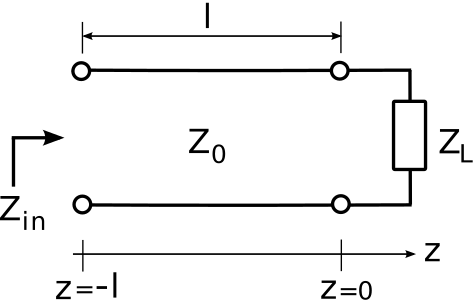3.15: Input Impedance of a Terminated Lossless Transmission Line
( \newcommand{\kernel}{\mathrm{null}\,}\)
Consider Figure 3.15.1, which shows a lossless transmission line being driven from the left and which is terminated by an impedance ZL on the right. If ZL is equal to the characteristic impedance Z0 of the transmission line, then the input impedance Zin will be equal to ZL. Otherwise Zin depends on both ZL and the characteristics of the transmission line. In this section, we determine a general expression for Zin in terms of ZL, Z0, the phase propagation constant β, and the length l of the line.
 Figure 3.15.1: A transmission line driven by a source on the left and terminated by an impedance ZL at z=0 on the right
Figure 3.15.1: A transmission line driven by a source on the left and terminated by an impedance ZL at z=0 on the right
Using the coordinate system indicated in Figure 3.15.1, the interface between source and transmission line is located at z=−l. Impedance is defined at the ratio of potential to current, so:
Zin(l)≜˜V(z=−l)˜I(z=−l)
Now employing expressions for ˜V(z) and ˜I(z) from Section 3.13 with z=−l, we find:
Zin(l)=V+0(e+jβl+Γe−jβl)V+0(e+jβl−Γe−jβl)/Z0=Z0e+jβl+Γe−jβle+jβl−Γe−jβl
Multiplying both numerator and denominator by e−jβl:
Zin(l)=Z01+Γe−j2βl1−Γe−j2βl
Recall that Γ in the above expression is: Γ=ZL−Z0ZL+Z0
Summarizing:
Equation ??? is the input impedance of a lossless transmission line having characteristic impedance Z0 and which is terminated into a load ZL. The result also depends on the length and phase propagation constant of the line.
Note that Zin(l) is periodic in l. Since the argument of the complex exponential factors is 2βl, the frequency at which Zin(l) varies is β/π; and since β=2π/λ, the associated period is λ/2. This is very useful to keep in mind because it means that all possible values of Zin(l) are achieved by varying l over λ/2. In other words, changing l by more than λ/2 results in an impedance which could have been obtained by a smaller change in l. Summarizing to underscore this important idea:
The input impedance of a terminated lossless transmission line is periodic in the length of the transmission line, with period λ/2.
Not surprisingly, λ/2 is also the period of the standing wave (Section 3.13). This is because – once again – the variation with length is due to the interference of incident and reflected waves.
Also worth noting is that Equation ??? can be written entirely in terms of ZL and Z0, since Γ depends only on these two parameters. Here’s that version of the expression: Zin(l)=Z0[ZL+jZ0tanβlZ0+jZLtanβl] This expression can be derived by substituting Equation ??? into Equation ??? and is left as an exercise for the student.
Finally, note that the argument βl appearing Equations ??? and ??? has units of radians and is referred to as electrical length. Electrical length can be interpreted as physical length expressed with respect to wavelength and has the advantage that analysis can be made independent of frequency.


